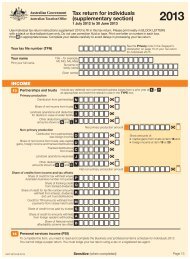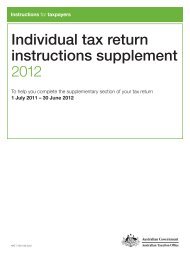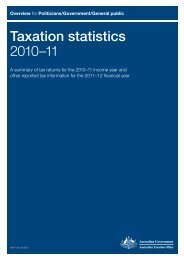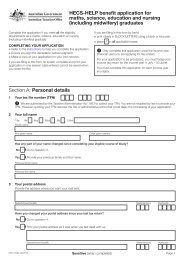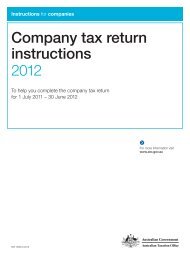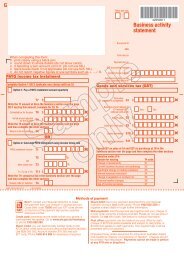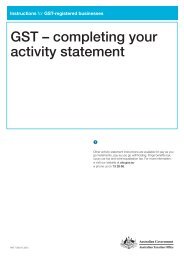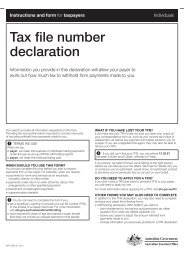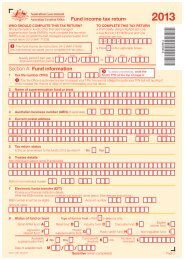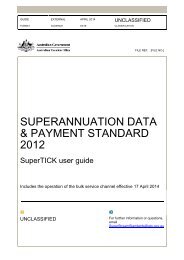Guide to depreciating assets 2013 - Australian Taxation Office
Guide to depreciating assets 2013 - Australian Taxation Office
Guide to depreciating assets 2013 - Australian Taxation Office
You also want an ePaper? Increase the reach of your titles
YUMPU automatically turns print PDFs into web optimized ePapers that Google loves.
value or claim the immediate deduction for <strong>depreciating</strong> <strong>assets</strong>costing $300 or less.Deductions for these <strong>assets</strong> are not available <strong>to</strong> a partnership.Costs incurred by a partnership are allocated <strong>to</strong> each partnerwho can then claim the relevant deduction for their share ofthe expenditure.There are no specific balancing adjustment rules for these<strong>depreciating</strong> <strong>assets</strong>. However, the <strong>assets</strong> may be consideredpart of the land for CGT purposes.When the land is disposed of, any deductions you haveclaimed, or can claim, for the <strong>assets</strong> may reduce the costbase of the land. See the <strong>Guide</strong> <strong>to</strong> capital gains tax <strong>2013</strong> formore information.Primary producers may also be able <strong>to</strong> claim deductionsfor capital expenditure on landcare operations, electricityconnections and phone lines; see Landcare operationson page 28 and Electricity connections and phone lineson page 29.Water facilitiesA water facility includes plant or a structural improvementthat is primarily and principally for the purpose of conservingor conveying water. It also includes an alteration, addition orextension <strong>to</strong> that plant or structural improvement. Examplesof water facilities are dams, tanks, tank stands, bores, wells,irrigation channels, pipes, pumps, water <strong>to</strong>wers and windmills.The meaning of water facility has been extended <strong>to</strong> includecertain other expenditure incurred on or after 1 July 2004:n a repair of a capital nature <strong>to</strong> plant or a structuralimprovement that is primarily and principally for thepurpose of conserving or conveying water (for example,if you purchase a pump that needs substantial work done<strong>to</strong> it before it can be used in your business, the cost ofrepairing the pump may be treated as a water facility)n a structural improvement, or an alteration, addition orextension <strong>to</strong> a structural improvement, that is reasonablyincidental <strong>to</strong> conserving or conveying watern a repair of a capital nature <strong>to</strong> a structural improvement thatis reasonably incidental <strong>to</strong> conserving or conveying water.Examples of structural improvements that are reasonablyincidental <strong>to</strong> conserving or conveying water are a bridge overan irrigation channel, a culvert (a length of pipe or multiplepipes that are laid under a road <strong>to</strong> allow the flow of water ina channel <strong>to</strong> pass under the road) and a fence preventinglives<strong>to</strong>ck entering an irrigation channel.Expenditure incurred on or after 1 July 2004 on a repair of acapital nature, or a change, <strong>to</strong> a <strong>depreciating</strong> asset may beeligible for the deduction for water facilities under the extendedrules. This is the case even though the pre 1 July 2004expenditure on the asset itself is not eligible for the deductionunder the rules before they were extended. This is becausethe repair or change <strong>to</strong> the asset is not treated as part of theasset under the extended rules, and the extended rules areseparately applied only <strong>to</strong> that repair or change.You can claim a deduction for the decline in value of a waterfacility in equal instalments over three income years.Unless you are an irrigation water provider, the expenditure mustbe incurred by you primarily and principally for conserving orconveying water for use in a primary production business thatyou conduct on land in Australia. You may claim the deductioneven if you are only a lessee of the land. Your deduction isreduced where the water facility is not wholly used for either:n carrying on a primary production business on land inAustralia, orn a taxable purpose.The deduction for water facilities was extended <strong>to</strong> irrigationwater providers for expenditure incurred on or after 1 July2004. An irrigation water provider is an entity whose businessis primarily and principally the supply of water <strong>to</strong> entities for usein primary production businesses on land in Australia. The supplyof water by the use of a mo<strong>to</strong>r vehicle is excluded.If you are an irrigation water provider, you must incur theexpenditure primarily and principally for the purpose ofconserving or conveying water for use in primary productionbusinesses conducted by other entities on land in Australia(being entities supplied with water by you). Your deductionis reduced if the water facility is not used wholly for ataxable purpose.If the expenditure incurred arises from a non-arm’s lengthdealing and is more than the market value of what theexpenditure was for, the amount of the expenditure is taken<strong>to</strong> be that market value instead.No deduction is available for capital expenditure incurred onacquiring a second-hand commercial water facility unless youcan show that no one else has deducted or could deduct anamount for earlier capital expenditure on the construction orprevious acquisition of the water facility.If you are a primary producer and a small business entity, youcan choose <strong>to</strong> work out your deductions for water facilitiesunder either the simplified depreciation rules or these UCArules. For more information about the simplified depreciationrules, see Small business entities on page 32.You may need <strong>to</strong> include a recoupment of expenditure onwater facilities in your assessable income. As the expenditureis deductible over more than one income year, special rulesapply <strong>to</strong> determine the amount of any recoupment <strong>to</strong> beincluded in assessable income in the year of recoupmentand in later income years. An amount received for the saleof a water facility for its market value is not regarded as anassessable recoupment.Horticultural plantsA horticultural plant is a live plant or fungus that is cultivatedor propagated for any of its products or parts.You can claim a deduction for the decline in value ofhorticultural plants, provided:n you owned the plants (lessees and licensees of land aretreated as if they own the horticultural plants on that land)n you used them in a business of horticulture <strong>to</strong> produceassessable income, andn the expense was incurred after 9 May 1995.Your deduction for the decline in value of horticultural plantsis based on the capital expenditure incurred in establishing theplants. This does not include the cost of purchasing or leasingland, or expenditure in draining swamp or low-lying land or onclearing land. It would include, for example:n the costs of acquiring and planting seeds, andn part of the cost of ploughing, con<strong>to</strong>uring, fertilising, s<strong>to</strong>neremoval and <strong>to</strong>psoil enhancement relating <strong>to</strong> the planting.26 a<strong>to</strong>.gov.au GUIDE TO DEPRECIATING ASSETS <strong>2013</strong>



